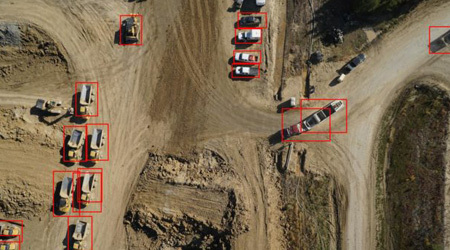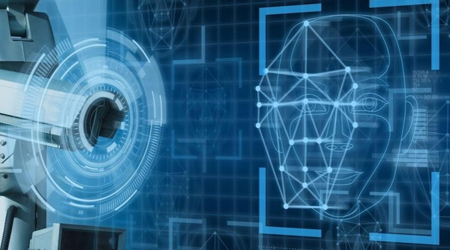Security in the future at drone-enabled construction sites
 By Anolytics | 08 October, 2023 in AI in Security | 3 mins read
By Anolytics | 08 October, 2023 in AI in Security | 3 mins read

Businesses, the world over are introducing some major transformations in operational capacities and deliveries and are going through a transformational phase. The need for broadening the spectrum of services has escalated. The construction sector is expanding exponentially and adopting cutting-edge practices for augmenting various on-site capabilities and making sites safe for human presence.
Constructions sites have a large number of human presence for the execution of a variety of complex tasks starting from air emissions & dust, handling of hazardous material, or lifting of heavy objects. Construction industry market players can be seen evaluating diverse measures to eliminate human involvement from hazardous locations. The introduction of drones, unmanned aerial vehicles or UAVs is a step towards executing a wide range of tasks without direct human involvement. For the construction business, UAVs have the ability to avert injury, death, toxic chemical exposures, electrical risks, and traumatic injury from vehicle and equipment collisions.
According to the United States Drone Market Report 2019, the commercial drone market in the United States has widened, with the market predicted to triple in size by 2024. Apart from this, drones’ numerous characteristics, such as precise controls, computer vision, GPS capabilities, geofencing, large carrying capacities, and artificial intelligence, make construction-focused UAVs capable of monitoring safety measures in commercial building tasks, saving humans from venturing into risky scenarios.
Let us look at the ways drones are enhancing construction site safety and efficiency.
1. Pre-Construction Inspections of sites
Starting with the pre-construction phase, site inspections are an important element of every phase of a building project. Some regions are unstable or difficult to access, this job can be highly risky for humans. Drone technology makes site inspectors’ jobs safer by allowing them to conduct inspections remotely without having to enter potentially dangerous regions. Drone inspections can be completed offsite in a short amount of time, saving money on additional people and other costs associated with delays. Drones can give precise measurements without the need for repeat inspections thanks to 3D mapping software, near- and far-infrared cameras, and laser range finders.
2. Structure construction monitoring
The scale of construction sites grows in tandem with the extent and complexity of construction projects. Indeed, one of the most difficult aspects of construction project management is keeping track of the structure construction progress. With drones, the site progress can be monitored and evaluated on internal parameters which help in estimating costs and investment of human effort involved in erecting additional constructional structures within the projects.
3. Maintenance inspections
Construction workers working on skyscrapers, towers, and bridges are at risk of falling from tremendous heights, and the preparations required to access them can be costly. Drones can perform scheduled maintenance inspections of these high structures in place of human inspectors. The data collected during the construction phase can be used to prepare for structure upkeep and to help building owners restore and update certain portions of a structure. Drones can detect leaks and even pinpoint places where leaks could occur using thermal imaging, allowing facility owners to manage their facilities more proactively.
Also Read: How Satellite Imagery Dataset Used in Artificial Intelligence: AI Applications for Satellite Imagery
AI Drones in coming years: From site safety to the future
While many companies have adopted Unmanned Aerial Vehicles to improve construction site safety, this adoption as a industry practice has the potential to benefit the entire market segment. AI-based drones can give game-changing results by keeping people away from life-threatening places by providing real-time data for continuous evaluation and speedy action on pressing points. Not only this, drones can serve a variety of critical businesses; thanks to AI-enabled computer vision technology for more effective training of autonomous flying capabilities.
Also Read: The Safety Framework in Autonomous Cars
The multi-faceted application for drones has broadened the way construction and many other labor-intensive functions are conducted so far. Technology has sneaked comfortably into the operational output of many diverse domains. Specific to drones in construction sites, training data for drone is required to detect numerous objects in a construction site. And among the autonomous flying training data, are tagged photographs of various objects that a drone may recognize using computer vision and move around while avoiding obstacles in its route. There are several companies like Anolytics providing quality image annotation services to ensure that drones can readily recognize a variety of things and be utilized for a variety of tasks that can actively participate in technology trends used for safeguarding human life.
please contact our expert.
Talk to an Expert →
You might be interested

- AI in Security 20 Jun, 2020
How to Improve AI Security Camera Performance with Image Annotation?
The use of security cameras in home security and round-the-clock surveillance become more popular among people globally.
Read More →
- AI in Security 15 Apr, 2021
How AI in Security Cameras Provide best Security Surveillance Solutions?
Public security and surveillance is becoming more important with the increase of crime and threats from illegal activiti
Read More →
- AI in Security 18 Nov, 2021
How AI-Powered Camera is Transforming Security and Surveillance in AI
One of the most recent technical advancements in the video surveillance market is security cameras with Artificial Intel
Read More →